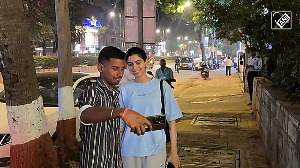While we try to make sense of the terror strikes in Mumbai on Wednesday evening that claimed 19 lives and injured nearly 130 people, there are discussions about the various possibilities behind the heinous plot.
Although the signature of the attacks points towards the Indian Mujahideen, we need to discuss other aspects surrounding the three blasts.
C D Sahay, former chief of the Research and Analysis Wing, India's external intelligence agency, helps decode the terror strikes.
The underworld angle is being spoken about and the word out on Mumbai's streets is that members of Dawood Ibrahim's gang could have carried out these attacks. Sahay feels this is not a theory that can be bought at the moment.
The Mumbai underworld operates in a manner which is aimed at targeting particular individuals, he says. The only exception where the underworld was behind a terror strike was the March 12, 1993 Mumbai serial blasts. Even then, notes Sahay, they were acting on someone else's behalf.
"Although this is a possible angle that could be explored, I would not make too much out of it at the moment," says Sahay.
"Look at the selection of targets and also the timing of the attacks. It is clearly designed to cause maximum damage. The idea was to create havoc and panic. The target was not a particular facility which was aimed at hurting the economy. Instead, what the attackers wanted to do was inflict damage, panic and kill people," says the former R&AW chief.
"I would not rush into anything and start blaming organisations. We need to have specific information for the same. It is the Intelligence Bureau which will have these inputs and they would be the best ones to tell us," adds Sahay.
"There are many aspects to this attack. It is never too easy to come to conclusions based on signatures of an attack. The law of terror defies the law of rationale and logic," adds Sahay.
"The other question is who could have done it at this time? I would reckon that militant groups do not have any real reason or cause to send that kind of a message to the government or the people at this moment," he says.
"However, there are a couple of things that are taking place and one among them is the India-Pak talks. Would some terror groups be trying to send a message related to that? They usually tend to do this. Now that Pakistan is down and out, terror groups would look to send messages stating, 'Don't think our agenda has changed just because Pakistan is down and out,'" says Sahay.
"Then there is also the India-US dialogue. If this is the reason for the attack, then the message is a larger one. If this is the reason, then the Indian Mujahideen is not the right group to carry out such an attack. It either has to be bigger terror groups like the Lashkar-e-Tayiba or Al Qaeda. The message to the US reaches louder only when groups like these carry out an attack," he adds.
"We have been facing such attacks many times in the past. The 26/11 attacks only increased the decibel level. The response mechanism may have improved, but then again that is not the only way to deal with such issues. It has to be intelligence driven. The fight has to begin right from the ranks of a constable. Our state police branches are still not up to the mark and this needs to improve. Inputs in whatever form is not being taken seriously. The police still do not work actively on bits and pieces of information. The police cannot expect to be spoon fed from New Delhi all the time," he says.
"I would also draw your attention to the response by Prime Minister Manmohan Singh. He constantly said, 'Keep me posted.' This is a very weak message that the PM has sent out. Look at the manner in which (US President Barack) Obama sat at the control room during the operation to eliminate (Al Qaeda leader) Osama bin Laden. Even during the Parliament attack it was our the PM (Atal Bihari Vajpayee) who led the discussion. He did not sit back and seek inputs."
"The seriousness of the government," Sahay adds, "is reflected in the prime minister's acts and statements."








